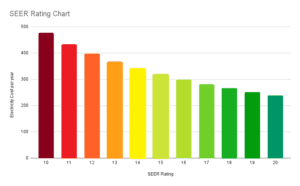Central Air Efficiency - AC SEER Rating Chart
If you’ve done any shopping for air conditioners recently, you’ve probably run across the term SEER score. So what is a SEER rating? To properly understand what an AC SEER rating is, let’s first explain what a SEER is.
What is a SEER Rating?
SEER stands for Seasonal Energy Efficiency Ratio, which is more or less self-explanatory when it comes to AC rating. This AC SEER rating describes how efficiently your air conditioner or heat pump can cool your home.
AC SEER ratings meaning
So what is a good SEER rating for an AC? And what is a bad one? Higher ratings are better; that is, the higher the score, the less electricity your air conditioner will use to provide the same amount of cooling power.
SEER ratings have increased quite substantially over the last few decades. Back in the 1970s, for instance, the average air conditioner SEER rating was 6. Today, the bare minimum is 9.7 for single-package AC systems and 10 for mini-split air conditioning systems. The AC SEER rating of a 20-year old air conditioner is therefore likely to be quite low, meaning it struggles to cool your home in an efficient manner and will use more energy than a newer model.
If you’re serious about saving money, though, there are plenty of air conditioning systems available with substantially higher AC SEER ratings. Top-of-the-line central air conditioners can get up to SEER 20, and ductless split systems can go even higher. Replacing your air conditioner with a more efficient model is a powerful way to save electricity; for instance, upgrading from an older SEER 9 air conditioning system to a high-efficiency SEER 18 AC unit will cut your energy usage in half. Here’s an AC SEER rating chart to help you visualize the relation between electricity costs and HVAC efficiency ratings:

As you can tell from this SEER chart, the higher your AC SEER rating, the less you will spend on energy costs per year as it represents your HVAC efficiency rating. You might therefore consider getting a slightly more expensive AC unit with a higher rating in order to save more money in the long run. This sketch also works as a Heat pump SEER rating chart.
Average SEER Rating by Year
Now that you have this SEER rating chart, you might not know what SEER value your air conditioning system is but maybe you have an idea of when it was first installed. That might give you an idea of how energy efficient your AC is based on the average SEER rating by year.

Of course, the older your air conditioner, the more chances that your SEER rating AC will be low. On another hand, if you AC unit was installed recently and a newer system was chosen, you might be in luck and already have an energy-efficient air conditioner!
For example, the seer rating of 20-year old air conditioner systems is likely to be between 10 to 12 whereas a newer unit purchased this year would have an average SEER rating of 15 or more.
AC SEER Rating Optimization
Every air conditioner has a nominal AC SEER rating provided by the manufacturer, but because no two homes are alike, your energy performance may vary. Depending on the local climate, home layout, quality of ductwork, and insulation, your actual efficiency may be higher or lower than the unit’s HVAC efficiency rating. When we install an air conditioner or heat pump in your home, our team of air conditioner technicians will analyze your cooling situation and give you an actual SEER rating that will describe your air conditioner’s performance specific to your home.
Frequently Asked Questions about AC SEER ratings
How to find SEER rating on your air conditioning
The AC SEER rating can usually be found on your cooling system directly, on a black and yellow sticker located either on the side or on the back of the unit. It will then display in large numbers what your SEER rating is.
How to improve your home’s energy efficiency without replacing your AC
Because SEER depends on more than the air conditioner itself, there are steps you can take to improve your energy efficiency without replacing your air conditioner. Adding more insulation to your home can help, as can having your ducts sealed. Even steps as simple as making sure to place the outdoor HVAC unit in the shade, which makes it easier for the air conditioner to remove heat from the home, can change your HVAC efficiency ratings. We’ll be happy to help you optimize your home for highly efficient cooling.
Is a Higher SEER rating better?
Yes, absolutely. An air conditioning unit with an AC SEER rating of 18 will be much more efficient than one with a rating of 11 and will result in significant energy savings as well. When shopping for a new air conditioning unit, look out for the SEER rating. A higher-rated AC system might represent a bigger investment at first, but is easily balanced out by energy savings in the long term.
What is a good SEER rating?
Wondering what SEER rating should you get? Know that, in general, the highest SEER value is always the better energy-efficient air conditioning but it also usually represents quite the investment. Aim for an air conditioner with at least a rating of 13 or 14 as anything less might end up costing you more money on the long term than you would save by buying a more energy-efficient model.
Call us at (413) 200-4203 for fast, reliable emergency AC services! Find your local Hurley & David today for fast, reliable emergency AC services in your area!


